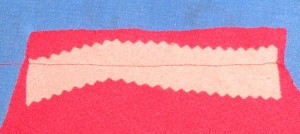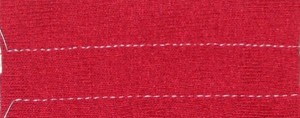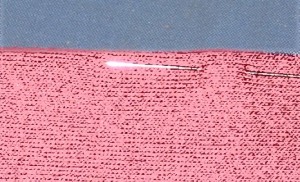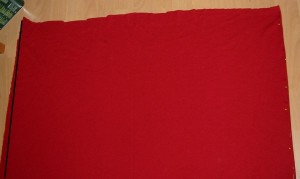Knits without a serger: seams with open seam allowances
Von gekauften Shirts sind wir es gewöhnt, daß sie mit der Overlock genäht sind und die Nahtzugaben infolgedessen zusammengenommen versäubert sind. Das erzeugt allerdings recht dicke Nähte und die mag ich persönlich nicht an allen Stellen.
Ganz besonders mag ich sie nicht an der Schulter und auch nicht unbedingt an der Ärmelnaht. Aber das Nette am selbermachen ist: Ich kann es anders machen.
An diesem Shirt arbeite ich an drei Stellen mit flachgebügelter Nahtzugabe: Die Schultern, die Ärmelnähte und die Teilungsnaht des Einfassbandes für den Ausschnitt. (Das ist die, die das Bild hier zeigt.)
When we look into a purchased shirt we are used to seams where the seam allowances are overcast together with a serger. This of course creates quite bulgy seams, something I do not like everywhere on a shirt.
I hate them on shoulder seams and I do not like them to much on the sleeveseams (depending on fabric and cut). But the nice thing about DIY: I can do it in a different way.
At this shirt I’m using flat seams (seam allowances ironed flat to both sides) on the shoulder seams, the sleeve seams and the seam that connects the two pieces of the band along the neckline. (That’s the seam shown on the pic above.)
Ein Vorteil ein Overlocknaht ist natürlich, daß sie sehr dehnbar ist. Eine normale Steppnaht der Nähmaschine ist das hingegen nicht.
Allerdings… selbst an einem Shirt will man gar nicht bei allen Nähten, daß sie dehnbar sind. Das Paradebeispiel dafür ist die Schulternaht. Hier näht man oft sogar einen Streifen Nahtband oder Stoff mit ein, um der Dehnung entgegen zu wirken. Also könnte man einfach eine gerade Steppnaht nähen und das Problem ist erledigt. Allerdings bleibt der Stoff dehnbar und durch die Steppnaht wird er an der Stelle relativ stark belastet, so daß die Gefahr besteht, daß auf Dauer der Stoff Schaden nimmt.
 Also verstärke ich den Stoff an einer Seite mit Vlieseline. Normalerweise würde ich da Formband nehmen, ich könnte auch schwören, daß ich da noch 5m von habe, aber irgendwie… finde ich das gerade nicht. Also muß G785 herhalten. Mit der Zackenschere geschnitten, damit sich keine Ränder abzeichnen. Und… äh… fürchterlich schief geschnitten. Aber die Naht trifft die Einlage überall. Also egal.
Also verstärke ich den Stoff an einer Seite mit Vlieseline. Normalerweise würde ich da Formband nehmen, ich könnte auch schwören, daß ich da noch 5m von habe, aber irgendwie… finde ich das gerade nicht. Also muß G785 herhalten. Mit der Zackenschere geschnitten, damit sich keine Ränder abzeichnen. Und… äh… fürchterlich schief geschnitten. Aber die Naht trifft die Einlage überall. Also egal.
Darüber nähe ich dann nicht mit einer Steppnaht, sondern mit einem minimalen Zickzackstich. Stichlänge 2,3, Stichbreite knapp 1. Das sieht aus wie eine “wackelige” Steppnaht, ist aber tatsächlich schon etwas elastisch. Gerade genug, um etwas Belastung vom Stoff wegzunehmen.
One big advantage of a serger is that the seams are elastic. A normal straight stitched seam with your sewing machine is not.
But even on a shirt we do not want all of the seams to have to much elasticity. The shoulder seams normally are sewn with some none elastic woven ribbon. So you could just straight stitch with your sewing maschine and that’s it. Okay, nearly. You can do this and you will get along with it on may fabrics, but there remains a risk that sooner or later the fabric will break, because the seam holds the still elastic fabric too much.
To prevent that I’m using some light fusible, usually on the back piece of my pattern. Normally I’d use Vlieseline Iron On Bias Tape and I am so sure I still have quite a lot of it but I cannot find it at the moment. So Vlieseline G785 had to do. Cut with my pinking shear to make sure no edge will show on the right side. And… yes… the cutting is quite not so straight at all. But the seam hits the interfacing, so it’s okay.
For sewing I change my straight stitch to a minimal zigzag, like stitch length 2.3, stitch width a tad less than one. The result looks like a wonky straight stitch, but has minimal stretch, enough to take away the stress from my fabric.
Um den Unterschied zu zeigen habe ich hier noch mal eine Probenaht mit hellem Faden genäht: Die untere Naht ist der normale Steppstich, die obere, etwas ungleichmäßg aussehende, ist in Wirklichkeit ein Zickzackstich. (Klick aufs Photo bringt ein größeres Bild.)
Here the difference: the lower stitching line is the normal straight stitch. The upper one, that looks a bit irregular, is a zigzag stitch. (Klicking on the pic brings the bigger version.)
Auch die Ärmelnaht nähe ich mit diesem Stich. Zumal mein Stoff in Längsrichtung ohnehin nicht sehr elastisch ist.
Braucht man eine elastischer Naht, etwa bei Kindern die unsanft am Ärmel ziehen oder bei Sportbekleidung die stärker dehnbar sein muß, dann muß man den Zickzackstich “steiler” machen. Kürzer und ggf. etwas breiter. Meine Maschine hat dafür eine Art “Sägezahnstich” für hochelastische Stoffe (Blick ins Handbuch der Maschine lohnt immer), man kann diesen aber durch einen Zickzackstich mit Länge 1-1,2 und einer Breite von 1,2-1,5 ersetzen. Einfach ausprobieren, was die gewünschte Wirkung hat. Solche Nähte kann man auch noch gut auseinanderbügeln, auch wenn sie nicht ganz so flach werden, wie eine normale Steppnaht.
For my sleeve seams I am using the same stitch. My fabric doesn’t have much stretch in the lengthwise direction anyhow.
If you need more elasticity in the seam (clothing for children who may pull on their sleeves or on garments for sport) you make the stitch steeper. Shorter stitch length, maybe a bit longer stitch width. My machine has a kind of “saw tooth” stitch for highly elastic fabrics build in (check the manual of your machine). Elseway you can set your zigzag stitch to length 1-1.2 and width 1.2-1.5. Just try what creates the stretch you need. Seams like that can not be ironed as flat as a straight stitched seam, but they are small enough to iron the seam allowances to both sides.
Das sind aber noch nicht alle Möglichkeiten für Säume in Jersey, die kommen in einem eigenen Beitrag.
That are not all possibilities to make seams in knits, more are to come yet.





